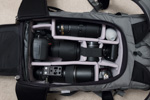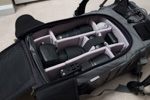Photography
"Any man who can see what he wants to get on film will usually find some way to get it; and a man who thinks his
equipment is going to see for him is not going to get much of anything."
- Hunter S. Thompson, 1962 letter to James Zanutto at Pop Photo magazine
I started doing photography as a kid with simple film cameras, and occasionally used disposable film cameras during college and early in my professional career, but it wasn't until 2004 that I really got serious with the purchase of a Nikon D70 DSLR kit. In 2003 I was on a trip to the Caribbean and found myself wasting really good scenery on a really bad camera, and the D70 was the solution. This digital photography thing has been going strong for me ever since.
As a sufficiently gadget-geek sort of pursuit with a smooth union of art and technology, photography of course deserves a page on my site with discussion and various relevant lists. My usual subjects include landscapes, bugs, flowers, wildlife, and almost anything else that catches my eye. The gear obsession peaked in the early 2010's with a trip to Alaska and a transition to full frame digital SLRs; as you can see in this handy chart (yes, I do track this data), the weight of it all got a bit out of control. Since then I've transitioned to a much smaller and lighter micro 4/3 kit, and spend a bit less time on photography overall. The ubiquity of high quality cameras in smartphones, and the need to invest tremendously in being in the right place at the right time to capture the right image, has resulted in the declines of both the traditional camera market and my own personal interest in photography, but that just means I'm not (usually) day-and-night obsessed as I once was.
At one time I was maintaining a separate site just for my photography.
Micro 4/3
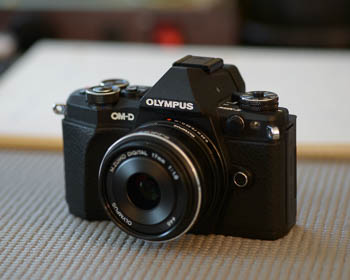 In late 2015 I found myself getting really tired
of lugging around a big SLR and lens kit, and pulled the trigger on something I'd been considering for a
long time: downsizing to micro 4/3, or m43 as it's usually shortened. The time
seemed right with the introduction of the Olympus OM-D EM-5 Mark II and its high-resolution mode. It's true
that 16 megapixels from a small sensor didn't compare favorably to the pristine 36 megapixels from the
D800E, and the
EM-5's high-resolution mode didn't work well in all situations (it definitely doesn't handle moving water
well, one of my favorite subjects), but I accepted that compromise to get a complete kit including
f/2.8 midrange and telephoto zooms at well under 10 pounds, with coverage from 24 to 420 mm equivalent focal
lengths. I still used my Nikon gear, but not really for travelling or hiking.
In late 2015 I found myself getting really tired
of lugging around a big SLR and lens kit, and pulled the trigger on something I'd been considering for a
long time: downsizing to micro 4/3, or m43 as it's usually shortened. The time
seemed right with the introduction of the Olympus OM-D EM-5 Mark II and its high-resolution mode. It's true
that 16 megapixels from a small sensor didn't compare favorably to the pristine 36 megapixels from the
D800E, and the
EM-5's high-resolution mode didn't work well in all situations (it definitely doesn't handle moving water
well, one of my favorite subjects), but I accepted that compromise to get a complete kit including
f/2.8 midrange and telephoto zooms at well under 10 pounds, with coverage from 24 to 420 mm equivalent focal
lengths. I still used my Nikon gear, but not really for travelling or hiking.
I actually have no plans to get any more lenses for my mirrorless system! Can you believe it? Then again, most people probably stop before having seven of them. Today I have a collection that can cover pretty much any need. The Olympus 12-40 and 40-150 f/2.8 PRO zooms are superb in terms of image quality, handling, and build. The 40-150 may be the best lens I've ever had on any system, and pairs well with the MC-14 1.4x teleconverter. My standard m43 light kit is the 12-40 and a "plastic fantastic" 40-150 R zoom, which certainly isn't as good as the pro zoom, but capable and much smaller. In late 2022 I did pick up the new OM System 40-150 f/4 PRO zoom, something I'd made note of when announced, in preparation for an upcoming trip. It pairs perfectly with the 12-40 f/2.8, and is much smaller and lighter than the big f/2.8 telephoto zoom while having much better image quality than the 40-150 R - basically a perfect compromise lens that served me very well on its first travel assignment. Occasionally I want just the camera and one small lens, in which case I use the 14-42 II R, although it's pretty rare that I wouldn't just use the 12-40 instead. Rounding out the collection are a 17 f/1.8 for a fast walkaround prime, 60 f/2.8 macro for the bugs and other small items, a Rokinon 7.5 f/3.5 fisheye, which is great for interiors when combined with the excellent Imadio (formerly Image Trends) Fisheye-Hemi Photoshop plug-in, and Laowa 10 f/2 Zero-D Hybrid wide angle prime, which I use primarily to take videos of myself on tennis courts. A couple accessories include the FL-LM3, a tiny yet fully functional flash unit that can tilt and rotate, and a Viltrox NF-M1 adapter, which allows mounting and autofocus of Nikon lenses. I got it primarily to have a super telephoto option with my Nikon 300 f/4. I also have a cheap Fotasy M42-M4/3 screw-mount adapter, on which I have mounted an ancient Pentax 50mm f/1.4 lens, and it actually works!
Nikon FX
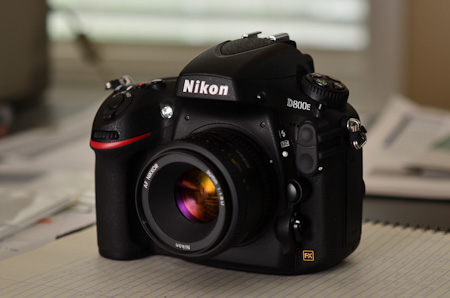 Behold, the Nikon D800E...
which was the absolute cutting edge of resolution and image quality among DSLRs when I purchased mine in
2012.
It took me until July that year to actually find one, right before a trip to Maine. I'd used several
different
DX cameras since buying the D70 in 2004, but the draw of all those megapixels and no AA filter, with my
imagined
desire to do Really Big Landscape Prints, was just too strong. (I say imagined because such a need is way
more theoretical
than actual for me.) It was also nice to get some pro-level features back
after spending some time with the D7000. The D800E isn't perfect, with some focus issues and the
locking-up-on-playback problem every now and then,
and the D800E is also a big and somewhat heavy camera by itself, let alone when combined with lenses that
are good enough to get the most from its sensor.
For tripod shooting I always use a Kirk Photo L-bracket.
These days the D800E gets pulled out to capture the really special shots
locally; my megapixel lust is no longer strong enough to justify lugging 20 pounds of gear on woodsy hikes
or onto planes in a carry-on.
Behold, the Nikon D800E...
which was the absolute cutting edge of resolution and image quality among DSLRs when I purchased mine in
2012.
It took me until July that year to actually find one, right before a trip to Maine. I'd used several
different
DX cameras since buying the D70 in 2004, but the draw of all those megapixels and no AA filter, with my
imagined
desire to do Really Big Landscape Prints, was just too strong. (I say imagined because such a need is way
more theoretical
than actual for me.) It was also nice to get some pro-level features back
after spending some time with the D7000. The D800E isn't perfect, with some focus issues and the
locking-up-on-playback problem every now and then,
and the D800E is also a big and somewhat heavy camera by itself, let alone when combined with lenses that
are good enough to get the most from its sensor.
For tripod shooting I always use a Kirk Photo L-bracket.
These days the D800E gets pulled out to capture the really special shots
locally; my megapixel lust is no longer strong enough to justify lugging 20 pounds of gear on woodsy hikes
or onto planes in a carry-on.
Of course I've gone through a pile of lenses for Nikon cameras since I innocently got into this digital photography thing with the D70 kit, almost all Nikkors. I've sold off many lenses over the years due to upgrades (especially all of my DX lenses), but still have a very capable kit:
- 24-70 f/2.8 G - my workhorse zoom, which is freaking huge for a midrange and still not quite as good as I'd like on the edges for landscapes.
- 35 f/1.8 DX - excellent small 42mm equivalent in FX 1.2 crop mode.
- 35 f/2 D - my second copy, which has character, but also horrible focus field curvature.
- 50 f/1.8 D - because it's not worth selling!
- 50 f/1.8 G - was supposed to be better than the D version, but altogether just meh.
- 60 f/2.8 G micro - for its fabulous rendering!
- 70-200 f/4 G VR - a much lighter and better-in-the-corners longer zoom than an f/2.8 version.
- 105 f/2.8 G VR micro - for longer macros and landscapes.
- 300 f/4 D AF-S - w/Kirk Photo replacement collar, showing its age in the squeaky focus motor, but still with superb quality and great close focus.
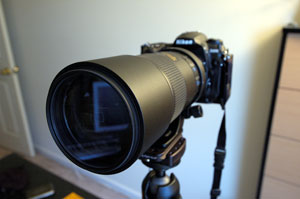 Accessories include
TC-14E II 1.4x and TC-17E II 1.7x teleconverters, SB-800, SB-400, two
R1 flash units,
and a whole bunch of miscellaneous items like the relatively rare Nikon 5T and 6T and Canon 500D closeup
diopters,
Nikon circular polarizers in various sizes, B+W neutral density filters in various strengths (0.9, 1.8, and
3.0), and a Kenko Uniplus 25mm autofocus
extension tube (which I am also trying to sell).
Accessories include
TC-14E II 1.4x and TC-17E II 1.7x teleconverters, SB-800, SB-400, two
R1 flash units,
and a whole bunch of miscellaneous items like the relatively rare Nikon 5T and 6T and Canon 500D closeup
diopters,
Nikon circular polarizers in various sizes, B+W neutral density filters in various strengths (0.9, 1.8, and
3.0), and a Kenko Uniplus 25mm autofocus
extension tube (which I am also trying to sell).
In my early days with Nikon gear I went a bit crazy with add-ons and accessories, such as trying many different options for getting closeups before getting a real macro lens. I have a love/hate relationship with the gear - I love the results of the big pro lenses, but hate the weight, cost, and being conspicuous as a photographer. After I got the D800E the weight and size became just too much, although the results were great. Micro 4/3 has been a nice compromise.
Other Cameras
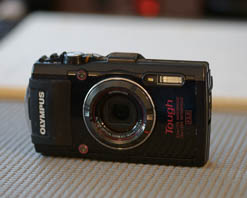 I've used a couple different underwater cameras
over the years, first a fairly low-end Panasonic TS-20 that died rather abruptly, and later an
Olympus Tough
TG-4 starting in 2016. Both are small sensor compact cameras, but the Olympus has been very durable and
gets
the job done. I discovered
underwater videos with the TG-4, and that's been a lot of fun while snorkeling.
I've used a couple different underwater cameras
over the years, first a fairly low-end Panasonic TS-20 that died rather abruptly, and later an
Olympus Tough
TG-4 starting in 2016. Both are small sensor compact cameras, but the Olympus has been very durable and
gets
the job done. I discovered
underwater videos with the TG-4, and that's been a lot of fun while snorkeling.
My compact camera of choice at one point was a Panasonic Lumix DMC-LX5. Compact cameras with large sensors were proliferating, but none had the fast, high-quality Leica f/2 zoom lens of the LX5, and plus it was little bigger than my Nikon 50/1.8 lens! Of course, for a truly compact and convenient camera, it's hard to beat an iPhone, which is why the camera industry is in such turmoil.
My wife has had a couple different compact cameras, first a Canon SD400 Digital Elph which died a watery death in the Baths in Virgin Gorda, and then a Canon SD-880 IS. They were small, and they shot JPEGs, and she liked them a lot. Now she just uses an iPhone.
I have in my possession a Sony Mavica, one of the old sub-megapixel digital cameras with a built-in floppy disk drive. It was my Dad's first digital camera and has since been passed down to me, because I am curious about junk like that and accumulate it.
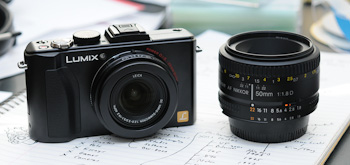 My Dad's last film camera was a Nikon FM2,
before he made the jump to digital, and again it wound up with me. The mirror slap on that bad boy
kicks like a mule, but it still takes pictures. It's got a few lenses and accessories as well, including a
Nikkor 50 f/1.8 series E lens, Promaster 28 f/2.8 lens,
Vivitar 70-150 f/3.8 zoom lens (probably a series E knockoff), and some ancient brand X flash unit:
"Acme-Lite T/815 Thyristor." For real.
My Dad's last film camera was a Nikon FM2,
before he made the jump to digital, and again it wound up with me. The mirror slap on that bad boy
kicks like a mule, but it still takes pictures. It's got a few lenses and accessories as well, including a
Nikkor 50 f/1.8 series E lens, Promaster 28 f/2.8 lens,
Vivitar 70-150 f/3.8 zoom lens (probably a series E knockoff), and some ancient brand X flash unit:
"Acme-Lite T/815 Thyristor." For real.
I even have a mid 80's Polaroid Sun 600 instant camera, the kind were loaded with 10-shot cartridges and spit out a print that would develop as you watched. Fixed focal length and fixed focus, with a pop-up flash and a tiny viewfinder more like a microsope. That camera went with me on several family trips.
Tripods and Support
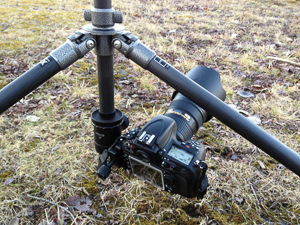 As a landscape and nature photographer, tripods have been key to getting great images, and I've had several
over the years. I started out with
a simple Manfrotto 3001N with 486 ballhead, and quickly transitioned to using Arca-Swiss mounts. I
still have the 3001N, but in customized form:
I replaced the stock center column with a short version, and cut all the leg pieces in half with a hacksaw.
It is now my very own model
desktop tripod, which I sometimes keep in the car for "photo emergencies." Prior to its second life in
miniature form, the 3001N was a bit small
for some of the big lenses, and that led me to a 3021BPRO, a big honking black aluminum tripod that I
wound up using very little due to its weight. I also had
a 676B monopod for a long time, but it wound up being used mostly to kill spiders on the ceiling, and
got trashed after some plastic bits
broke (not related to the spider-killing). Incidentally, I now mostly have a live-and-let-live relationship with our spider tenants.
As a landscape and nature photographer, tripods have been key to getting great images, and I've had several
over the years. I started out with
a simple Manfrotto 3001N with 486 ballhead, and quickly transitioned to using Arca-Swiss mounts. I
still have the 3001N, but in customized form:
I replaced the stock center column with a short version, and cut all the leg pieces in half with a hacksaw.
It is now my very own model
desktop tripod, which I sometimes keep in the car for "photo emergencies." Prior to its second life in
miniature form, the 3001N was a bit small
for some of the big lenses, and that led me to a 3021BPRO, a big honking black aluminum tripod that I
wound up using very little due to its weight. I also had
a 676B monopod for a long time, but it wound up being used mostly to kill spiders on the ceiling, and
got trashed after some plastic bits
broke (not related to the spider-killing). Incidentally, I now mostly have a live-and-let-live relationship with our spider tenants.
My search for lighter, better tripods led inexorably to Gitzo. Today I have two, a standard-sized GT2540 4-section carbon fiber tripod with Markins M10 ballhead, and GT1550T 5-section carbon fiber travel tripod with Markins Q3T ballhead. Both get used at home, depending on the need, and the traveller goes with me while hiking or flying. There are lot of carbon-fiber tripod choices these days, but the Gitzos have been excellent to use and durable.
Specifically for underwater videos (because they are much more interesting than still shots), I use a SeaLife AquaPod Mini with a SeaLife Dragon Mini 650 dive light and the TG-4 attached to the end. The combination lets me start a video and then stick the camera down into crevices or near the bottom to really get close to the critters.
I would be remiss if I didn't mention a couple other critical parts of my gear: straps and clips. My standard camera straps are cheap-but-awesome Quantaray neoprene neck straps that I picked up years ago; I have three of them. The best shoulder strap I've seen, and the one I typically use with the D800E, is an Optech Utility Strap Sling. I also spent years figuring out how to carry a camera while hiking; with standard neck straps, the camera swings all over the place, like into rocks and trees, which is not good. A better solution was a pair of smaller straps with clips hanging from my backpack shoulder straps, sometimes supplemented with a bungee cord to keep a big lens like the Nikon 24-70/2.8 under control against my chest. Eventually I discovered Peak Design's Capture clips, which attach to a belt or backpack strap and mount the camera via an Arca-Swiss type plate. I got first a CapturePRO V2 and then a Capture V3. They are the best solution I have seen to date for this particular problem.
Camera Bags
I'm one of those people who obsesses about camera bags, because I like to travel and mostly do landscape and nature photography. That means I need bags that fit (all together now) in the overhead bin or under the seat in front of me, and also are comfortable for walking without getting in the way of the gear. I'm clearly not the only one, based on this guy's awesome write-up.
Different situations dictate a variety of gear and bags to carry it. My ultimate go-anywhere kit these days is my iPhone, which I usually have in my back pants pocket or in the rear pocket of a bike jersey, so that one is easy. I just don't use compact cameras now, except for the TG-4 when the going gets tough.
Next up is my standard small kit, which is the E-M5 II with one or two lenses. Although I do have a really small variable aperture kit zoom, usually I have the 12-40 pro lens attached, and often I have a 40-150 with me. If I'm using the 40-150 R, all of this fits very well into a Lowepro Rezo 110 AW shoulder bag along with a flash, filter, and a couple batteries. For travel, I mainly use the 40-150 f/4, with the camera and lens both stuffed into an A-Mode SPX02 shoulder bag, along with the tiny flash and spare batteries. The A-Mode first very neatly into the top of my small travel backpack, a Jansport Equinox 28. The backpack itself is a bit cramped, but has tons of pockets and fits very nicely under airline seats.
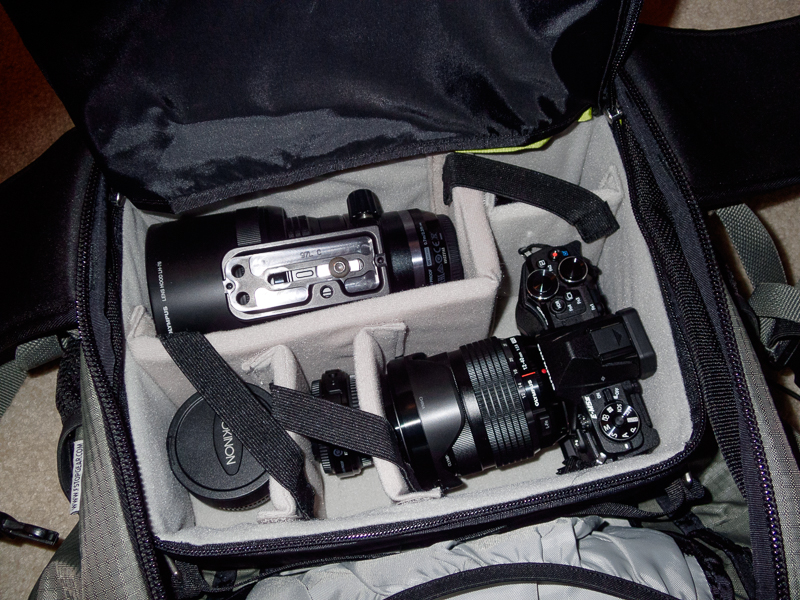 For a bigger kit, I tend towards one of two main choices: either the Rezo 110 or A-Mode in combination with other
gear in a regular backpack (in particular,
the 40-150 f/2.8 pro zoom in its Olympus case carried in an REI trail 25 or the Jansport),
or everything in my F-Stop Loka backpack with the small
ICU. The Loka is a more robust solution for photography,
but more of a pain to deal with on flights: it fits under the seat, but is a tight squeeze and
doesn't leave much legroom. For all
its awesomeness, the Loka is lacking in pockets for other non-photography travel gear, yet
is still the best solution I've
found so far for a bigger kit, since it is comfortable for hiking, flexible, and opens in reverse (the part that is
usually against your back). It's easy to
carry a tripod in one side pocket and a water bottle in the other.
For a bigger kit, I tend towards one of two main choices: either the Rezo 110 or A-Mode in combination with other
gear in a regular backpack (in particular,
the 40-150 f/2.8 pro zoom in its Olympus case carried in an REI trail 25 or the Jansport),
or everything in my F-Stop Loka backpack with the small
ICU. The Loka is a more robust solution for photography,
but more of a pain to deal with on flights: it fits under the seat, but is a tight squeeze and
doesn't leave much legroom. For all
its awesomeness, the Loka is lacking in pockets for other non-photography travel gear, yet
is still the best solution I've
found so far for a bigger kit, since it is comfortable for hiking, flexible, and opens in reverse (the part that is
usually against your back). It's easy to
carry a tripod in one side pocket and a water bottle in the other.
If the D800E is involved, which it usually isn't, something bigger is necessary. The absolute minimum is a single small lens in a Lowepro Topload Zoom 1, but usually I'll just have the camera by itself. For bigger lenses or more lenses, without much walking, a shoulder pack like my Rezo 160 AW or Rezo 190 AW can do that job. For a bigger full kit - and what's the point of bringing the D800E without it? - the only reasonable choice is the F-Stop Loka with the Large Pro ICU. That combo can fit the D800E, 24-70, 70-200 f/4, and 300 f/4 plus some smaller items, but not much room is left in the bag for anything else.
I've tried a lot of other bags over the years, all of which had one or more flaws. Shoulder bags are generally bad, other than for carrying a set of gear from one place to another in a car. Single-shoulder sling bags look good in theory, but the uneven weight distribution makes them uncomfortable for any period of time. I still have a Lowepro Slingshot 100 AW for those rare times when it's just right, and sold off a Slingshot 200 AW because it was just not comfortable. I've tried a great many backpack options over the years until I settled on the Loka; they all came up short in one way or another. My first camera backpack was a Lowepro Mini Trekker AW, which had plenty of space but was basically just a box with straps. Innovative designs like Lowepro's Inverse 100 AW, Versapack 200 AW, and Flipside 400 AW looked promising, but didn't work out in real usage. For a while I thought the Clik Elite Medium Nature Pack was the end of my quest: supremely comfortable and adjustable, and really well made. Unfortunately, it's pretty heavy by itself, and lacks the rear opening feature of the Loka. I also tried a Clik Elite Medium SLR Chest Pack and didn't like it at all.I also have a collection of individual Lowepro lens cases of various sizes, a couple bottle bags (which are great), miscellaneous utility bags, and of course all of the mostly-useless OEM cases and lens bags that come with the gear.
Stuff I've Sold
 Being a Nikon fanboy at the time, and wanting a smaller, lighter kit, I bought into the Nikon 1 system -
although
I only did it when the bodies were being sold at a substantial discount. First came the V1, and later
a V2 when half the sensor on my V1 went bad. The whole system got a bad rap due to the small 1"
sensor,
but the output was often acceptable, somewhat comparable to earlier DX cameras,
especially considering that a whole kit of camera and lenses would fit in a small bag. I especially liked that the
system
was compatible with most Nikon F-mount lenses via the FT-1 adapter, enabling some really super
telephoto shooting
with long 35mm lenses like my 300 f/4 (which yielded an insane 1377mm equivalent field of view with the 1.7x
TC).
Unfortunately, the limitations of the 1" sensor were real, and I just never got used
to the cameras - the handling wasn't great, too many functions were only in menus, and they just felt dinky.
My full Nikon 1 kit included the cameras, 10 f/2.8 CX wide angle prime, 10-30 f/3.5-5.6 CX VR
kit zoom, 18.5 f/1.8 CX fast normal prime, 30-110 f/3.8-5.6 CX VR telephoto zoom,
SB-N5 flash, and the FT-1 adapter. The whole lot got boxed up for an enthusiastic eBay buyer in early
2021.
Being a Nikon fanboy at the time, and wanting a smaller, lighter kit, I bought into the Nikon 1 system -
although
I only did it when the bodies were being sold at a substantial discount. First came the V1, and later
a V2 when half the sensor on my V1 went bad. The whole system got a bad rap due to the small 1"
sensor,
but the output was often acceptable, somewhat comparable to earlier DX cameras,
especially considering that a whole kit of camera and lenses would fit in a small bag. I especially liked that the
system
was compatible with most Nikon F-mount lenses via the FT-1 adapter, enabling some really super
telephoto shooting
with long 35mm lenses like my 300 f/4 (which yielded an insane 1377mm equivalent field of view with the 1.7x
TC).
Unfortunately, the limitations of the 1" sensor were real, and I just never got used
to the cameras - the handling wasn't great, too many functions were only in menus, and they just felt dinky.
My full Nikon 1 kit included the cameras, 10 f/2.8 CX wide angle prime, 10-30 f/3.5-5.6 CX VR
kit zoom, 18.5 f/1.8 CX fast normal prime, 30-110 f/3.8-5.6 CX VR telephoto zoom,
SB-N5 flash, and the FT-1 adapter. The whole lot got boxed up for an enthusiastic eBay buyer in early
2021.
Few of my compact cameras have been in good enough shape to sell - my wife's SD-400 drowned in saltwater, and my underwater Panasonic TS-20 sprang a leak and probably died of internal corrosion. My Panasonic LX5 did go to an eBay buyer in 2022 after many years sitting unused, its small portable role largely stolen by iPhones.
My DSLR journey started with the D70 and then progressed through the D200, D300, and D7000 before I went over to FX. None were perfect, although the D200 was pretty close even if it only had 10 megapixels. Each generation added more megapixels and more features, but also sometimes new compromises. During a trip to Alaska in 2011, I brought both the D300 and D7000, and sometimes had both cameras going at the same time. All have departed my possession via the convenience of eBay. I've also gotten rid of every one of my DX lenses.
Speaking of lenses, I've had a lot of them over the years; tried some, tried others, changed my mind, sometimes repurchased a lens I thought I didn't want but wound up missing:
- 200 f/4 AI - The idea was to have a lighter weight 200mm lens, but I never really used it, and discarded via eBay in 2023.
- AF-S 70-200 f/2.8 G VR - Nikon's original professional fast zoom with VR (vibration reduction), which was mostly a sports lens but superbly built and had great image quality on DX cameras. Not so great on FX - strong vignetting. I kept it for a long time mostly "just in case" I needed a fast aperture telephoto, which I usually don't. By the time it went to a new owner in 2023 via eBay, it was four generations old, but still working great.
- TC17E-II 1.7x teleconverter - Mainly employed to turn my 300mm f/4 into a 510mm f/6.7, I hardly ever used it.
- AF-S 24-85 f/3.5-f/4.5 G VR - A solid midrange zoom, with Nikon's standard lower end build, that I never really liked.
- 10.5 f/2.8 DX fisheye - Mainly used for interiors, and replaced by the Rokinon 7.5mm fisheye for m43.
- Tokina 11-16 f/2.8 AT-X PRO DX - A very nice and well-built ultra-wide lens for DX cameras, and a serviceable 16mm lens on FX. Once I went FX I never really used it.
- AF-S 70-300 f/4.5-f/5.6 G VR - Another 70-300 variable aperture zoom, better than my previous one, but still without the great handling of better lenses.
- AF-S 17-55 f/2.8 G DX - The standard professional midrange zoom for DX cameras, which I used extensively. Much maligned for its field curvature, but really not much different from other similar lenses. Useless once I went to FX.
- AF-S 16-85 f/3.5-f/3.6 G DX VR - In hindsight, a really good lens. Didn't have the full professional build of higher end lenses, but produced great images, had a very useful range, and had among the best build quality among Nikon's non-pro options.
- AF-S 85 f/3.5 G DX VR micro - Nikon's long macro for DX cameras. This was my third copy - I forget why I returned the first one, the second one had something legitimately bad at close focus and produced soft images, and the third was great.
- 35 f/2 D - I had one that I loved as a "normal" 50mm equivalent on DX. That lens had character. On FX, image quality wasn't great.
- AF-S 12-24 f/4 G DX - This was a really good wide-angle zoom. Unfortunately, I dropped it once, and the zoom was never that smooth again.
- AF-S 18-200 G VR - Nikon's first superzoom for DX cameras, with which I was at first enthralled and then eventually disappointed.
- Tamron 90 f/2.8 Di macro - A great macro lens in its day, although without internal focusing.
- 70-300 f/4-5.6 ED - The original inexpensive 70-300 zoom when DSLRs were first introduced, it had a number of issues, like softness at 300mm. My least favorite feature was the external focusing with the rotating front element.
- 28 f/2.8 D - I forget why I bought this. I didn't have it very long.
- AF-S 18-70 f/3.5-4.5 G DX - Nikon's original consumer-level DX lens, which in hindsight was a pretty good lens. Similar to the later 24-85 on FX.
Some other random things: Nikon SB-400 flash, Manfrotto 3149 micrometric focusing rail, Nikon SC-29 remote flash cable, Sigma EM-140 DG macro flash, Nikon DR-6 right-angle viewfinder.
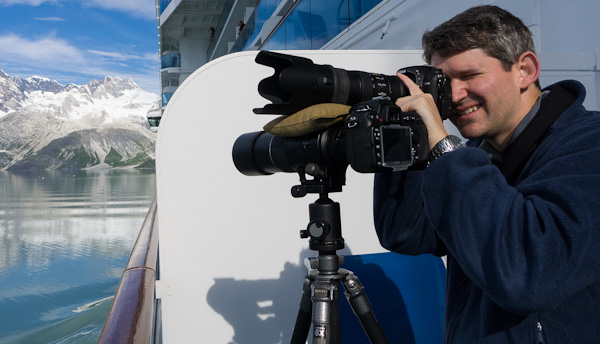
Multitasking
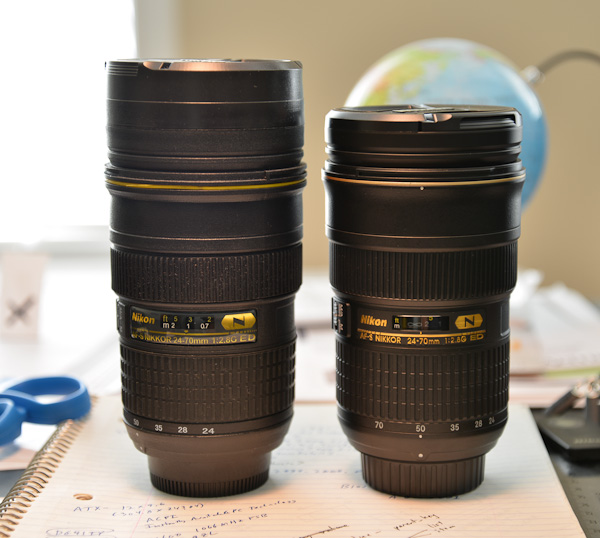
Which is the mug, and which is the lens?
